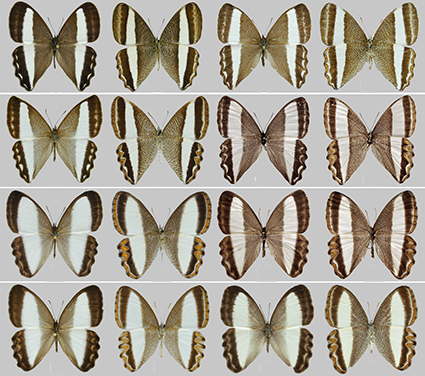Abstract
A new, and only the third known species of the Neotropical montane genus Oressinoma Doubleday is described—O. sorina n. sp., from the Andes of central Peru. It is distinguishable immediately from the other two congeners by the shape of the hindwing underside submarginal orange band, and by the male genitalia. The systematics of Oressinoma are reviewed. A preliminary analysis is carried out based on COI barcode confirming the separate specific status of O. sorina n. sp. in relation to other two congeners. Both barcode and genital morphology data suggest that the widespread O. typhla Doubleday may be a complex of allopatric or, locally parapatric species. The genus Oressinoma is the only neotropical member of the predominantly Australian subtribe Coenonymphina, represented in the entire Holarctic by one genus only—Coenonympha Hübner, considered as the putative sister-genus of Oressinoma. Their origins and relationships are briefly discussed.
References
DeVries, P.J. (1987) s.n. In: The butterflies of Costa Rica and their natural history. Papilionidae, Pieridae, Nymphalidae. Princeton University Press, Princeton-Guilford, New Jersey, pp. 277–283.
Espeland, M., Breinholt, J., Willmott, K.R., Warren, A.D., Vila, R., Toussaint, E.F.A., Maunsell, S.C., Aduse-Poku, K., Talavera, G., Eastwood, R., Jarzyna, M.A., Guralnick, R., Lohman, D.J., Pierce, N.E. & Kawahara, A.Y. (2018) A Comprehensive and Dated Phylogenomic Analysis of Butterflies. Current Biology, 28, 1–9. https://doi.org/10.1016/j.cub.2018.01.061
Espeland, M., Breinholt, J.W., Barbosa, E.P., Casagrande, M.M., Huertas, B., Lamas, G., Marín, M.A., Mielke, O.H.H., Miller, J.Y., Nakahara, S., Tan, D., Warren, A.D., Zacca, T., Kawahara, A.Y., Freitas, A.V.L. & Willmott, K.R. (2019) Four hundred shades of brown: Higher level phylogeny of the problematic Euptychiina (Lepidoptera, Nymphalidae, Satyrinae) based on hybrid enrichment data. Molecular Phylogenetics and Evolution, 131, 116–124. https://doi.org/10.1016/j.ympev.2018.10.039
Folmer, O., Black, M., Wr, H., Lutz, R. & Vrijenhoek, R. (1994) DNA primers for amplification of mitochondrial Cytochrome C oxidase subunit I from diverse metazoan invertebrates. Molecular Marine Biology and Biotechnology, 3, 294–299.
Forster, W. (1964) Beiträge zur Kenntnis der Insektenfauna Boliviens, XIX. Lepidoptera III. Satyridae. Veröffentlichungen der Zoologischen Staatssammlung München, 8, 51–188.
Freitas, A.V.L. & Brown, K.S. (2004) Phylogeny of the Nymphalidae (Lepidoptera). Systematic Biology, 53 (3), 363–383. https://doi.org/10.1080/10635150490445670
Hall, T.A. (1999) BioEdit: A User-Friendly Biological Sequence Alignment Editor and Analysis Program for Windows 95/98/NT. Nucleic Acids Symposium Series, 41, 95–98.
Klots, A.B. (1956) Lepidoptera. In: Tuxen, S.L. (Ed.) Taxonomist’s glossary of genitalia in insects. Ejnar Munksgaard, Copenhagen, 97–110.
Kumar, S., Stecher, G., Li, M., Knyaz, C. & Tamura, K. (2018) MEGA X: Molecular Evolutionary Genetics Analysis across computing platforms. Molecular Biology and Evolution, 35, 1547–1549. https://doi.org/10.1093/molbev/msy096
Lamas, G., Viloria, A.L. & Pyrcz, T.W. (2004) Tribe Satyrini, Subtribe Pronophilina. In: Lamas, G. (Ed.), Checklist. Part 4A. Hesperioidea—Papilionoidea. In: Heppner, J.B. (Ed.), Atlas of Neotropical Lepidoptera. Vol. 5A. Association for Tropical Lepidoptera Scientific Publishers, Gainesville, Florida, pp. 205–224.
Losada, M.E., Neild, A.F.E. & Viloria, A.V. (2018) The life cycle of Oressinoma typhla Doubleday, [1849] (Lepidoptera: Nymphalidae: Satyrinae). Tropical Lepidoptera Research, 28 (2), 54–60. https://doi.org/10.5281/zenodo.1435815
Marín, M.A., Cadavid, I.C., Valdés, L., Álvarez, C.F., Uribe, S.I., Vila, R. & Pyrcz, T.W. (2017) DNA Barcoding of an Assembly of Montane Andean Butterflies (Satyrinae): Geographical Scale and Identification Performance. Neotropical Entomology, 46 (5), 514–523. https://doi.org/10.1007/s13744-016-0481-z
Matos Maravi, P., Peña, C., Willmott, K.R. & Freitas, A.V.L. (2013) Systematics and evolutionary history of butterflies in the “Taygetis clade” (Nymphalidae: Satyrinae: Euptychiina): Towards a better understanding of Neotropical biogeography, Molecular Phylogenetics and Evolution, 66 (1), 54. https://doi.org/10.1016/j.ympev.2012.09.005
Mitchell, A., McClay, A.S., Pohl, G.R. & Sperling, F.A.H. (2005) PCR-based methods for identification of two Eteobalea species (Lepidoptera : Cosmopterigidae) used as biocontrol agents of weedy Linaria species (Scrophulariaceae). Canadian Entomologist, 137, 129–137. https://doi.org/10.4039/n03-104
Peña, C., Wahlberg, N., Weingartner, E., Kodandaramaiah, U., Nylin, S., Freitas, A.V. & Brower, A.V.Z. (2006) Higher level phylogeny of Satyrinae butterflies (Lepidoptera: Nymphalidae) based on DNA sequence data. Molecular Phylogenetics and Evolution, 40 (1), 29–49. https://doi.org/10.1016/j.ympev.2006.02.007
Pyrcz, T.W., Lorenc-Brudecka, J., Zubek, A., Prieto, C., Boyer, P., Florczyk, K., Wacławik, B. & Lachowska-Cierlik, D. (2018) Considerations on the taxonomy of the genus Arhuaco Adams and Bernard 1977, and its relationships with the genus Pronophila Doubleday [1849] (Nymphalidae, Satyrinae). Neotropical Entomology, 48 (2), 302–313. https://doi.org/10.1007/s13744-018-0641-4
Pyrcz, T.W. (2004) Pronophiline butterflies of the highlands of Chachapoyas in northern Peru: faunal survey, diversity and distribution patterns (Lepidoptera, Nymphalidae, Satyrinae). Genus, 15 (4), 455–622.
Pyrcz, T.W., Collins, S., Zubek, A., Wacławik, B., Sáfián, Sz., Bąkowski, M. & Florczyk, K. (2020) Previously unrecognized diversity of Afrotropical Melanitini butterflies (Nymphalidae, Satyrinae): doubling the number of species and genera. Arthropod Systematics & Phylogeny, 78 (2), 171–216. https://doi.org/10.26049/ASP78-2-2020-01
Razowski, J. (1996) Słownik morfologii owadów. PWN, Warszawa, 431 pp.
Simon, C., Frati, F., Beckenbach, A., Crespi, B., Liu, H. & Flook, P. (1994) Evolution, weighting, and phylogenetic utility of mitochondrial gene sequences and a compilation of conserved polymerase chain reaction primers. Annals of the Entomological Society of America, 87, 651–701. https://doi.org/10.1093/aesa/87.6.651
Tamura, K. & Nei, M. (1993) Estimation of the number of nucleotide substitutions in the control region of mitochondrial DNA in humans and chimpanzees. Molecular Biolology and Evolution, 10, 512–526.
Wootton, R.J. (1979) Function, homology and terminology in insect wings. Systematic Entomology, 4 (1), 81–93. https://doi.org/10.1111/j.1365-3113.1979.tb00614.x


